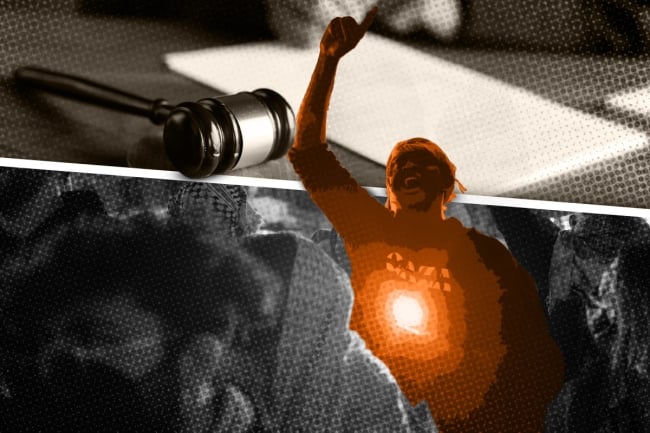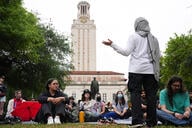You have /5 articles left.
Sign up for a free account or log in.

Only 88 student protesters were arrested in fall 2024.
Photo illustration by Justin Morrison/Inside Higher Ed | Katrin Bolovtsova/Pexels | Spencer Platt/Getty Images
After an unprecedented spring of pro-Palestinian protests on campuses across the United States, the fall semester has been comparatively quiet. The total number of protest actions declined by more than 64 percent, from 3,220 to 1,151, according to data from the Crowd Counting Consortium, a project by Harvard University’s John F. Kennedy School of Government and the University of Connecticut that collects data on protests.
The number of students arrested for protesting dropped even more precipitously. Last spring, 3,572 students were arrested in connection with their involvement in protests as pro-Palestinian encampments proliferated on campus quads, starting with the one launched at Columbia University on April 17. But in the fall, only 88 student protesters were arrested. (For the purposes of this article, numbers for the spring were calculated using data from Jan. 1 to July 1 and from July 1 to Dec. 17 for the fall.)
The decline can certainly be attributed in part to a natural loss of momentum following the fever pitch the movement reached in the spring. But some free speech advocates believe that the restrictive expressive-activity policies some institutions introduced over the summer and early fall may have discouraged students from protesting.
The policies ranged from banning the erection of tents on campus grounds to limiting the times and places where students are allowed to hold demonstrations.
While free speech experts agree that some time, place and manner restrictions are acceptable, they have branded some policy changes unconstitutional. The Foundation for Individual Rights and Expression singled out New York University’s highly controversial new conduct code, which states that attacks against “Zionists” can be considered discrimination or harassment, as the term can be construed as an attack on individuals for their Jewish or Israeli identity.
“NYU’s policy as written sweeps into its ambit a large amount of protected political speech,” FIRE wrote to the institution. “With an ongoing war in the Middle East, speech that strongly advocates for—or against—the Israeli or Palestinian cause cannot help but be offensive to many people. With few exceptions, it nevertheless remains, and must remain, free from official punishment.”
Pro-Palestinian demonstrators last spring frequently rallied against Zionists and Zionism; some encampments featured signs that read “No Zionists,” and protesters chanted slogans such as “the Zionists have got to go.”
Confusing Language
But it’s not just the policies themselves that have contributed to the decline in protests. FIRE’s director of policy reform, Laura Beltz, noted that many students struggled to parse the complex, bureaucratic language of the policies, leaving them uncertain about what was, in fact, permitted.
“We’ve gotten a lot of questions from students just trying to navigate the policies, because these are really lengthy documents,” she said. “Some of these [rules] for when you have to reserve a space or when you have to give advanced notice are really confusing.”
At UMass Boston, for example, students are now expected to give five days’ notice before protests or demonstrations, but exceptions can be made “when protests or demonstrations are caused by news or affairs coming into the public knowledge less than 24 hours previously.” FIRE has criticized the policy for its vagueness, arguing that it leaves it to administrators to determine when relevant information came “into public knowledge.”
“Because news is constantly changing, whether a demonstration is caused by news or affairs occurring within the past day is an inherently subjective assessment,” the organization wrote in a letter to the university. “The difficulty and subjectivity of these calculations invite administrators to make self-serving arguments about which ‘news or affairs’ are recent enough to permit impromptu demonstrations.”
Students may also be wary of holding protests after observing the severe backlash their peers experienced during the spring, when thousands were arrested—including some who alleged the police used force. Others faced institutional sanctions and online or in-person harassment.
Furthermore, numerous students who faced conduct charges or arrests in the spring continued to be affected by sanctions like suspension this fall, which keeps them off campus and thus unable to engage in protests. Others received deferred suspensions, which often require students to stay out of trouble for a certain period of time to avoid a harsher punishment.
Jay Ulfelder, program director of Harvard’s Nonviolent Action Lab and one of the researchers on the Crowd Counting Consortium, said that this semester has also seen a shift in the manner of protest, with two types becoming more common: vigils, which increased from 168 in the spring to 217 in the fall, and “study-ins”—where students silently work on their computers while displaying signs bearing messages of protest—which jumped from five in the spring to 63 this semester.
“Part of that is organizers trying, as they say, to keep the focus on the people of Gaza. Part of it is also, I think, it looks worse for an administrator when they’re actively preventing a vigil where people are holding candles and remembering people who died,” Ulfelder said.
Of course, those demonstrations were not without their own controversies; a series of study-ins at Harvard, for example, ended in 12 students and 25 faculty members being banned from the library for two weeks due to the institution’s ban on demonstrations in the library.




